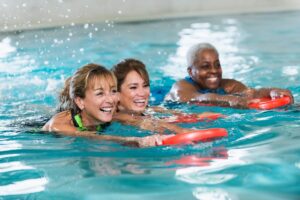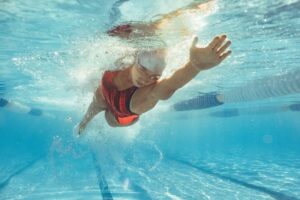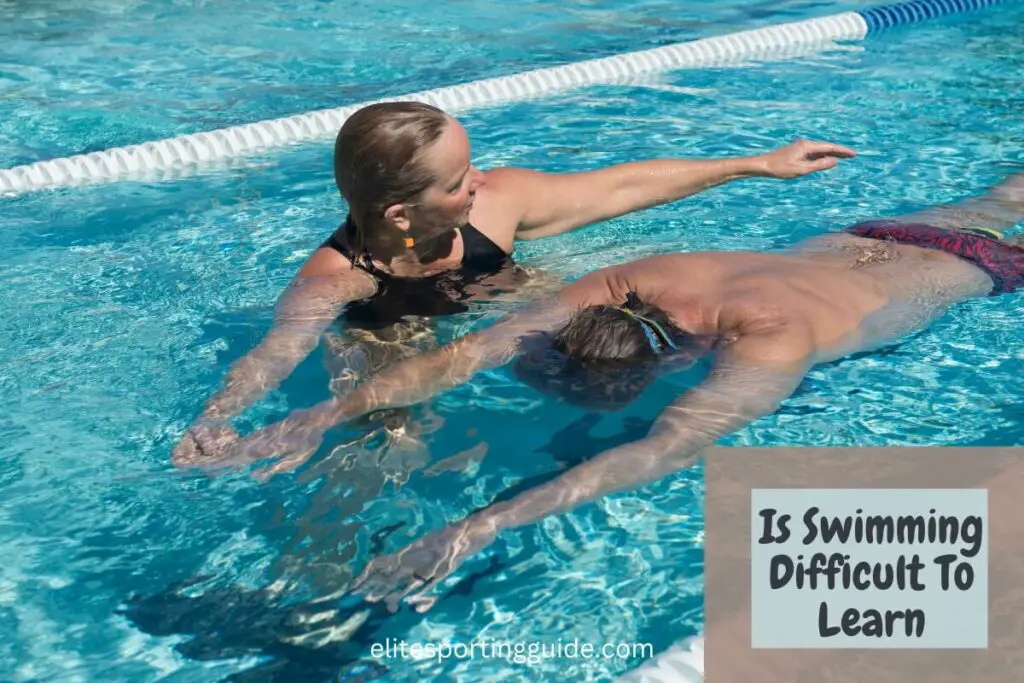Swimming, considered both a life-saving skill and a popular recreational activity, can vary in difficulty from person to person.
This article explores the factors that influence the ease or difficulty of learning to swim, including individual comfort in the water, age, and previous experience.
By shedding light on the challenges and rewards of acquiring this invaluable skill, readers will gain a deeper understanding of what it takes to become a proficient swimmer.
Is Swimming Difficult To Learn?
Learning to swim can vary in difficulty from person to person. For some individuals, it comes naturally and is relatively easy to pick up, while others may find it more challenging. Proper instruction, practice, and comfort in the water significantly influence the ease with which someone can learn to swim.
Individual Comfort in Water

Individual comfort in the water is important in determining how quickly and effectively someone learns to swim.
This comfort, or lack thereof, can be influenced by a variety of factors, each of which plays a role in a person’s swimming journey.
Here are some of the key factors that come into play when assessing an individual’s comfort in the water:
1. Previous Experiences: Positive or negative experiences in the water can greatly affect a person’s comfort level.
Someone who had enjoyable experiences, such as family outings to the pool during childhood, may be more comfortable in the water than someone who had a traumatic water-related incident.
2. Age and Developmental Stage: Young children tend to adapt to water more easily, as they often have fewer inhibitions and fears.
However, older individuals can also become comfortable in the water with the right instruction and encouragement.
3. Fear and Anxiety: Fear of the water is a common barrier to comfort. Fear can stem from a lack of familiarity, past negative experiences, or a general fear of drowning.
Overcoming fear through gradual exposure and patient instruction is key.
4. Learning Environment: The environment in which someone learns to swim can affect their comfort level.
A calm, clean, and well-maintained pool with supportive instructors can help learners feel more at ease.
5. Physical Fitness: Physical fitness and body awareness can impact comfort in the water. Individuals who are physically fit and have good body control may find it easier to adapt to swimming movements.
6. Communication and Trust: Effective communication between the learner and the instructor builds trust and confidence.
Instructors who understand the individual’s fears and concerns can tailor instruction to address them.
7. Adaptive Techniques: Instructors can use adaptive techniques to accommodate individuals with specific needs or challenges.
For example, those with disabilities may require specialized instruction or equipment to feel comfortable in the water.
8. Personal Motivation: Personal motivation plays a significant role. Those who are determined to learn to swim and are willing to step out of their comfort zones are more likely to make progress.
9. Cultural and Social Factors: Cultural norms and social influences can affect a person’s attitude toward swimming. In some cultures, swimming is less common, leading to varying levels of comfort in the water.
10. Repetition and Exposure: Like any skill, repetition and exposure to water are key to building comfort.
The more time someone spends in the water, the more comfortable they are likely to become.
Ultimately, individual comfort in the water is a complex interplay of physical, psychological, and environmental factors.
Age and Swimming Proficiency: Does It Make a Difference?

Age and swimming proficiency refer to the correlation between an individual’s age and their ability to acquire and excel in swimming skills.
This relationship is a multifaceted one, as it takes into account the diverse physical, cognitive, and emotional aspects that change as a person grows older.
For children, learning to swim can be both exciting and challenging.
Their physical development is still evolving, which can affect their coordination and strength in the water.
Additionally, children may have different psychological responses to the water, ranging from enthusiasm to apprehension.
Effective swimming instruction for kids often involves a focus on building water confidence, basic stroke development, and water safety awareness.
In the case of teenagers, age can bring both advantages and hurdles in swimming proficiency.
Teenagers typically have more developed physical capabilities compared to younger children, which can facilitate faster progress in acquiring swimming techniques.
However, they might also face distractions or self-consciousness that can impact their commitment to swim training.
For adults, learning to swim later in life might present certain challenges related to fear or discomfort in the water.
Nonetheless, with the right guidance and persistence, adults can overcome these barriers and discover the joys and health benefits of swimming, even if they start at an older age.
Previous Experience and Learning Curves
Previous experience in swimming can significantly influence an individual’s learning curve when trying to acquire new swimming skills.
Here are some insights into how prior experience can affect the process of learning to swim:
1. Novice Swimmers (No Previous Experience)
Novice swimmers with no prior experience in the water often start with a steep learning curve. Everything, from water entry to basic buoyancy, can feel unfamiliar.
Learning foundational skills such as floating, submerging, and basic stroke mechanics may take time and patience.
Fear and anxiety about the water are common among novice swimmers, and instructors should focus on building water confidence.
2. Intermediate Swimmers (Limited or Informal Experience):
Individuals with limited or informal experience in swimming may have some basic skills but lack proper technique and proficiency.
Their learning curve can vary depending on the quality of their prior experience. Those who have received some basic instruction may progress more quickly than those who have only dabbled in swimming.
Intermediate swimmers often benefit from refining their existing skills and correcting any bad habits.
3. Experienced Swimmers (Competitive or Recreational):
Experienced swimmers, whether in competitive or recreational settings, generally have a smoother learning curve when acquiring new skills or strokes.
They may already possess strong foundational skills, allowing them to adapt to new techniques more rapidly.
For experienced swimmers, the learning curve may be less about mastering basic skills and more about fine-tuning advanced strokes or mastering specific swimming disciplines.
4. Cross-Training Athletes (Experience in Other Sports):
Individuals with experience in other sports, such as triathletes or water polo players, may have transferable skills that can expedite their learning in swimming.
Cross-training athletes often have good cardiovascular fitness and body awareness, which can benefit their swimming progress.
They may need to adapt their existing skills to the unique demands of swimming, such as mastering breathing and stroke techniques.
Previous experience plays a significant role in a person’s learning curve when it comes to swimming.
While novice swimmers may face a steeper initial challenge, those with prior experience, even in related sports, can often progress more quickly due to their existing physical fitness and comfort in the water.
However, regardless of previous experience, the key to successful swimming instruction is personalized guidance, practice, and a commitment to improving technique and water confidence.
Overcoming Common Challenges in Swimming Instruction
Overcoming common challenges in swimming instruction is essential to ensure that learners have a positive and effective experience in the water.
Here are some of the typical challenges faced in swimming instruction and strategies to address them:
1. Breathing Difficulty: Proper breathing is fundamental to swimming, but it can be challenging for beginners. Instructors should teach rhythmic breathing techniques and encourage learners to practice breath control separately from stroke work.
2. Inadequate Technique: Learning correct swimming technique is imperative. Instructors should focus on breaking down strokes into manageable components, emphasizing body position, arm movement, and kicks separately before integrating them into full strokes.
3. Limited Pool Access: Not everyone has easy access to a pool.
Instructors can suggest alternatives like practicing in lakes, rivers, or community pools.
Additionally, dry-land exercises can help develop strength and coordination when access to water is limited.
4. Age-Related Challenges: Young children and older adults may have unique challenges. For kids, keeping lessons engaging and fun is key, while older adults may need adaptations to accommodate physical limitations.
5. Group Size: Large class sizes can make it challenging for instructors to provide individual attention.
Smaller group sizes or private lessons can be more effective for personalized instruction.
6. Progress Plateaus: Some learners may reach a point where they feel stuck or frustrated with their progress. Instructors should offer constructive feedback, set achievable goals, and introduce new drills to keep learners motivated.
8. Safety Concerns: Water safety is paramount.
Instructors should prioritize teaching safety rules and emergency procedures to ensure that learners are confident in their ability to handle unexpected situations in the water.
9. Inconsistent Practice: Encouraging students to practice outside of lessons can be a challenge.
Instructors should stress the importance of regular practice and provide resources or home exercises to reinforce skills.
10. Parental Involvement: For young children, parental involvement can be both an asset and a challenge.
Instructors should maintain clear communication with parents and provide guidance on how parents can support their child’s swimming progress.
By recognizing and addressing these common challenges, swimming instructors can create a more inclusive, effective, and enjoyable learning experience for their students.
The Importance of ‘Proper Instruction & Practice’ and ‘Gaining Confidence in the Water’
“The Importance of Proper Instruction and Practice” and “Gaining Confidence in the Water” are two essential aspects of learning to swim.
1. The Importance of Proper Instruction and Practice:
Proper instruction is major when learning to swim. Instructors can provide structured guidance, demonstrate correct swimming techniques, and offer immediate feedback to help students develop their skills efficiently and safely.
They can tailor lessons to the individual needs and abilities of learners, gradually progressing from basic strokes to more advanced techniques.
Learning correct form from the beginning is essential to prevent the development of bad habits that can hinder progress and potentially lead to safety issues in the water.
Practice goes hand-in-hand with instruction.
Consistent and dedicated practice is key to reinforcing swimming skills. It helps individuals build muscle memory, endurance, and confidence in the water.
The more one practices, the more comfortable and capable they become.
2. Gaining Confidence in the Water
Confidence is a fundamental aspect of swimming. Many beginners, especially children and adults who are new to the water, may initially feel fear or anxiety.
Gaining confidence involves both psychological and practical aspects.
Instructors can create a supportive and safe learning environment, gradually introducing learners to deeper water and more challenging exercises as their confidence grows.
Building confidence also includes understanding water safety principles, which can help individuals feel more secure in aquatic environments.
Gradually overcoming fears and anxieties associated with water is a major part of the learning process.
Post you may be interested in: Can Swimming Damage Your Eyes?
Becoming a Proficient Swimmer

Becoming a proficient swimmer offers a wide range of benefits that extend beyond the basic ability to stay afloat and move through the water.
Here are some of the key advantages of achieving proficiency in swimming:
1. Water Safety: Proficient swimmers have a strong understanding of water safety principles.
They are better equipped to recognize and respond to potential dangers in aquatic environments, making them less likely to encounter accidents or emergencies while in the water.
2. Physical Fitness: Swimming is an excellent full-body workout that engages various muscle groups.
Proficient swimmers often experience improved cardiovascular health, increased strength, enhanced flexibility, and better overall fitness.
It’s a low-impact exercise, making it suitable for people of all ages and fitness levels.
3. Stress Reduction: Swimming is known for its stress-relieving properties.
The rhythmic motion and tranquility of the water can help reduce stress, anxiety, and promote relaxation.
Swimming can be an effective way to unwind and clear one’s mind.
4. Weight Management: Regular swimming can contribute to weight management and help individuals maintain a healthy body weight.
It burns calories while building muscle, making it an excellent choice for those looking to lose weight or stay in shape.
5. Improved Posture and Balance: Swimming encourages good posture and balance as swimmers strive to maintain proper body alignment in the water.
This can translate to better posture and balance in daily life.
6. Social Opportunities: Swimming is a social activity that can be enjoyed with friends and family.
Joining swim clubs or participating in water-based sports opens up opportunities for social interaction, camaraderie, and making new friends.
7. Life-Long Skill: Once acquired, swimming is a skill that individuals can use throughout their lives. It offers a means of recreation, exercise, and relaxation that can be enjoyed at any age.
8. Competitive Opportunities: Proficient swimmers may choose to participate in competitive swimming events.
This not only adds excitement and motivation to one’s swimming routine but also presents opportunities for personal growth and achievement.
9. Water-Based Activities: Proficient swimmers can partake in various water-based activities such as snorkeling, scuba diving, water polo, and triathlons.
These activities expand one’s horizons and open the door to new aquatic experiences.
Post you may like: Is Swimming A Good Exercise?
Tips and Strategies for Easier Swimming Skill Acquisition
Acquiring swimming skills can be a rewarding journey, and here are some tips and strategies to make the process easier and more effective:
1. Start with Professional Instruction: Enroll in swimming lessons led by certified instructors. They can provide proper guidance, correct your form, and ensure you learn the basics correctly from the beginning.
2. Set Realistic Goals: Establish clear and achievable swimming goals. Break down your objectives into smaller, manageable milestones to track your progress and stay motivated.
3. Consistent Practice: Regular practice is essential to improve swimming skills. Commit to a consistent practice schedule to build muscle memory and endurance.
The more you practice, the more comfortable and proficient you’ll become.
4. Focus on Technique: Pay attention to proper swimming technique. Practice strokes, kicks, and breathing exercises with precision.
Proper technique is the foundation of efficient and safe swimming.
5. Breathing Control: Mastering breathing techniques is crucial for swimming.
Practice rhythmic breathing and learn when to inhale and exhale during each stroke.
Breathing control reduces fatigue and enhances your swimming experience.
6. Water Comfort: Spend time in the water to increase your comfort level. Play games, float, and gradually explore deeper water as you become more at ease.
The more relaxed you are, the easier it is to learn and progress.
7. Use Floatation Devices: If you’re a beginner or lack confidence, consider using floatation devices like kickboards or swim noodles.
These tools provide support while you focus on specific aspects of swimming.
8. Learn Water Safety: Understanding water safety principles is essential.
Familiarize yourself with pool rules, rescue techniques, and how to respond in emergency situations to ensure your safety and that of others.
9. Seek Feedback: Don’t hesitate to ask for feedback from experienced swimmers or instructors.
Constructive criticism can help you identify areas for improvement and refine your skills.
10. Vary Your Practice: Mix up your practice routine to keep it engaging.
Try different strokes, drills, and activities to challenge yourself and prevent boredom.
11. Visualization: Mentally rehearse your swimming techniques and routines. Visualization can improve your confidence and help you focus on the correct movements.
12. Swim with Others: Join a swim club or swim with friends. Swimming with others can be motivating, and you can learn from their experiences and techniques.
13. Warm-Up and Cool Down: Prioritize warm-up exercises to prepare your body for swimming and cool-down stretches to prevent muscle soreness.
14. Stay Patient and Persistent: Learning to swim takes time, and progress may be gradual. Be patient with yourself, and don’t get discouraged by setbacks.
Keep working towards your goals.
15. Enjoy the Process: Embrace the joy of swimming.
Enjoy the feeling of being in the water, the freedom it provides, and the sense of accomplishment as you become a more proficient swimmer.
Swimming’s Accessibility and Rewards
In conclusion, swimming, while it may pose initial challenges to some, ultimately proves to be an accessible and rewarding skill to acquire.
Regardless of age or prior experience, the journey of learning to swim offers a multitude of benefits that extend far beyond the pool’s edge.
Swimming is a skill that not only enhances physical fitness but also fosters water safety awareness, stress reduction, and improved mental well-being.
It is an activity that can be enjoyed throughout one’s life, from childhood to adulthood, offering social opportunities and the chance to participate in various water-based sports and activities.
With the right instruction, consistent practice, and a commitment to building confidence in the water, individuals can unlock the many rewards that come with becoming a proficient swimmer.
Whether it’s the sense of accomplishment in mastering a new skill, the joy of gliding through the water, or the peace of mind that comes from knowing how to stay safe in aquatic environments, swimming truly offers an enriching and accessible experience for all.



